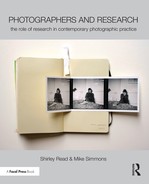Photographers and Research in Higher Education
Introduction
As a counterpoint to the reflections and work of the established photographers who have contributed to this book, we thought it would be useful to take a look at the role of research in a Higher Educational (HE) setting. The level of engagement in research and how this influences the creative process is illustrated through the following three case studies. Each provides an insider account of the personal experiences and arc of learning that different levels of study provide within the HE framework.
Many HE courses in the UK such as the undergraduate Bachelor of Arts (BA) and postgraduate Masters of Arts (MA) are modular in structure. The modules provide a mix of both practical and written work and the level of achievement in terms of knowledge and skill that students are expected to achieve is based on a credit system that relates to a set of assessment criteria known as Learning Outcomes.
For photography students in HE, in common with photographers in a professional context, ‘research’ is generally understood as the process of thinking, planning and information gathering that influences the decisions made in the creation of an art work. In other words a process that is for most practitioners, ‘a necessary part of their everyday practice’.1 Research in this sense is centred on the personal goals of the maker and ‘any assertions embodied in [the art works] are rarely supported by empirical evidence’.2
So, for example, at BA level the core learning is concerned with the basics. This includes developing a portfolio of generic knowledge including research skills and critical awareness and understanding of historical and contemporary practices as well as extending the practical skills necessary to engage with photography at an advanced level. For example, Thu Thuy Pham describes the Final Major Project of her BA (Hons) Fashion Photography course as ‘the consolidation of specific subject knowledge’. Rather than simply taking photographs students are encouraged to use photography as a tool of investigation, which involves accurate interpretation or analysis of the information garnered through the research process and as Thu Thuy Pham highlights, ‘synthesise the findings into final outcomes appropriate for your subject specialism’.
With the basics in place MA level, although still modular in structure, is geared much more to achieving a greater level of autonomy in the learning process. The Learning Outcomes are focused on increasing critical awareness and analytical thinking through the reshaping or considering of information and materials in other ways.
For example, Charlotte Fox explains how research at masters level has helped her discover her ‘own creative voice’ which has helped to ‘… shape me as an artist’.
Within a practice-based Doctoral Programme there is no modular structure or credit system and research is defined differently as ‘a process of investigation leading to new insights, effectively shared’.3 PhD student Maria Paschalidou describes her experience as ‘… the way hybrid forms of knowledge create a dynamic context for theory and practice to collide and evolve in new ways,’ and in this sense it is the process not the product that is important. An approach that Scrivener identifies as ‘… art making [that] is undertaken in order to create apprehensions (i.e., that is objects that must be grasped by the senses and the intellect)’.4 The art work created cannot be understood without reference to an in-depth written critical thesis that supports it and vice-versa; art work and knowledge building are interdependent on one another.
So the meaning of research in HE is understood differently depending on the level of study being undertaken and to what end the outcomes of the research process are designed. But whatever the definition of research might be, research remains fundamental to the creation of artwork that has relevance and meaning for maker and audience for the work.
Notes
1 Linda Candy (2006). Practice Based Research: A Guide. Creativity & Cognition Studios. See: University of Technology, Sydney CCS Report: 2006–V1.0 November. See www.creativityandcognition.com.
2 See Órla Cronin (2006). Psychology and Photographic Theory. In Prosser, J. (ed).: Image-based Research. A Sourcebook for Qualitative Researchers. Oxon: Routledge.
3 See: Research Excellence Framework: Second consultation on the assessment and funding of research, HEFCE, September 2009/38 at http://webarchive.nationalarchives.gov.uk/20100202100434/http://www.hefce.ac.uk/pubs/year/2009/200938/.
4 S. A. R. Scrivener (2002). The Art Object Does Not Embody a Form of Knowledge, Working Papers in Art and Design. See: www.herts.ac.uk/__data/assets/pdf_file/0008/12311/WPIAAD_vol2_scrivener.pdf.
